
A crossbow is a ranged weapon using an elastic launching device consisting of a bow-like assembly called a prod, mounted horizontally on a main frame called a tiller, which is hand-held in a similar fashion to the stock of a long gun. Crossbows shoot arrow-like projectiles called bolts or quarrels. A person who shoots crossbow is called a crossbowman, an arbalister or an arbalist.

A catapult is a ballistic device used to launch a projectile a great distance without the aid of gunpowder or other propellants – particularly various types of ancient and medieval siege engines. A catapult uses the sudden release of stored potential energy to propel its payload. Most convert tension or torsion energy that was more slowly and manually built up within the device before release, via springs, bows, twisted rope, elastic, or any of numerous other materials and mechanisms.

The ballista, plural ballistae or ballistas, sometimes called bolt thrower, was an ancient missile weapon that launched either bolts or stones at a distant target.
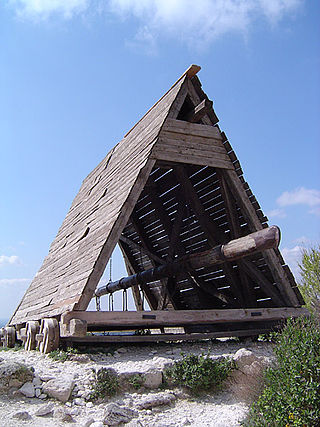
A siege engine is a device that is designed to break or circumvent heavy castle doors, thick city walls and other fortifications in siege warfare. Some are immobile, constructed in place to attack enemy fortifications from a distance, while others have wheels to enable advancing up to the enemy fortification. There are many distinct types, such as siege towers that allow foot soldiers to scale walls and attack the defenders, battering rams that damage walls or gates, and large ranged weapons that attack from a distance by launching projectiles. Some complex siege engines were combinations of these types.
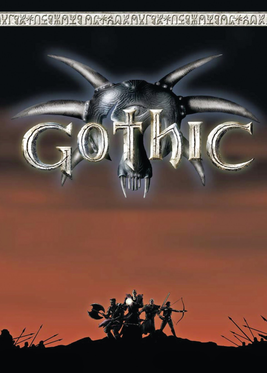
Gothic is a 2001 action role-playing video game developed by Piranha Bytes for Microsoft Windows and the first game of the game series of the same name. It was released on 15 March 2001 in Germany, on 30 October 2001 in Europe, on 23 November 2001 in North America and on 28 March 2002 in Poland. A Nintendo Switch port, titled Gothic Classic, was released worldwide on September 28, 2023.

King's Bounty is a turn-based fantasy video game designed by Jon Van Caneghem and published by New World Computing in 1990. The game follows the player's character, a hero of King Maximus, appointed with the job of retrieving the Sceptre of Order from the forces of chaos, led by Arech Dragonbreath. King's Bounty is notably considered the forerunner of the Heroes of Might and Magic series of games.

Conquest of the Empire is a military strategy board game set in the Roman Empire after the death of Marcus Aurelius, with 2 to 6 players pitting their armies against each other in an attempt to become the ruler of Rome. The game was created in 1982 by Larry Harris and published by The Citadel under the title VI Caesars. Harris revised the game for Milton Bradley in 1984 to be reissued under the title Conquest of the Empire as part of the Gamemaster series. The game was re-released in the summer of 2005 by Eagle Games, redesigned by Glenn Drover. The gameplay in Conquest of the Empire shares similarities to Axis & Allies, another Larry Harris project within the same series.

Nox is an action role-playing game developed and published by Westwood Studios and Electronic Arts in 2000 for Microsoft Windows. It details the story of Jack, a young man from Earth who is pulled into a high fantasy parallel universe and has to defeat the evil sorceress Hecubah and her army of necromancers to return home. Depending on the player's choice of character class at the beginning of the game, the game follows three largely different linear storylines, each leading to its unique ending.
Roman siege engines were, for the most part, adapted from Hellenistic siege technology. Relatively small efforts were made to develop the technology; however, the Romans brought an unrelentingly aggressive style to siege warfare that brought them repeated success. Up to the first century BC, the Romans utilized siege weapons only as required and relied for the most part on ladders, towers and rams to assault a fortified town. Ballistae were also employed, but held no permanent place within a legion's roster, until later in the republic, and were used sparingly. Julius Caesar took great interest in the integration of advanced siege engines, organizing their use for optimal battlefield efficiency.

Warlords IV: Heroes of Etheria is a turn-based strategy video game developed by Infinite Interactive and published by Ubi Soft. It is the fourth in the Warlords series.
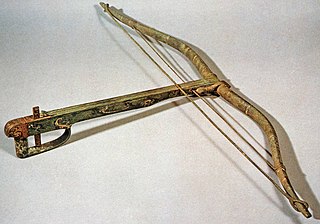
It is not clear where and when the crossbow originated, but it is believed to have appeared in China and Europe around the 7th to 5th centuries BC. In China the crossbow was one of the primary military weapons from the Warring States period until the end of the Han dynasty, when armies were composed of up to 30 to 50 percent crossbowmen. The crossbow lost much of its popularity after the fall of the Han dynasty, likely due to the rise of the more resilient heavy cavalry during the Six Dynasties. One Tang dynasty source recommends a bow to crossbow ratio of five to one as well as the utilization of the countermarch to make up for the crossbow's lack of speed. The crossbow countermarch technique was further refined in the Song dynasty, but crossbow usage in the military continued to decline after the Mongol conquest of China. Although the crossbow never regained the prominence it once had under the Han, it was never completely phased out either. Even as late as the 17th century AD, military theorists were still recommending it for wider military adoption, but production had already shifted in favour of firearms and traditional composite bows.

Dragon Rage is a PlayStation 2 game by The 3DO Company. The player controls an escaped dragon named Cael Cyndar on a mission to save the dragon race from extinction by the orcs. Cael's guide is Adara the Sprite. The dragon's attacks include ramming, biting, grabbing & dropping, and breathing fire. Whenever Cael eats orcs, he gains Mana points. Eating farm animals replenishes Health. When Cael releases captured sprites, they give information or teach Cael about his magical powers. Orc forces include ground units, naval units (ships), air units, castle defenses (towers), and war machines (catapults). There are many animations and cut scenes. The game was originally intended to be a Might and Magic title. The title originally going to be Dragon Wars of Might and Magic. However, as the story did not truly coincide with the Might and Magic universe the title was dropped.
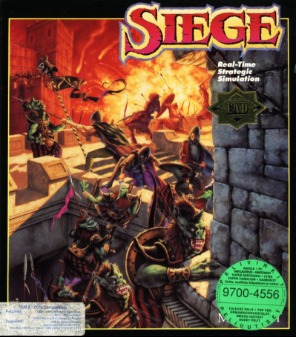
Siege is a video game released by Mindcraft in 1992 for MS-DOS. An expansion pack, Dogs of War, was released. It added multiplayer, six new castles, and 16 new units to the game. A sequel, Ambush at Sorinor, was released in 1993.

A fortified tower is one of the defensive structures used in fortifications, such as castles, along with defensive walls such as curtain walls. Castle towers can have a variety of different shapes and fulfil different functions.
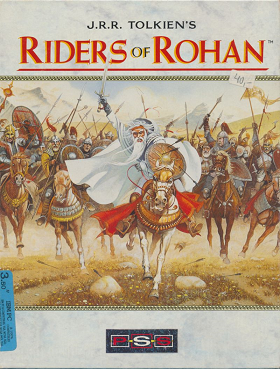
J. R. R. Tolkien's Riders of Rohan is a computer video game from 1991 based upon the fictional War of the Ring set in the Middle-earth world created by J. R. R. Tolkien, centered in The Lord of the Rings novels. The massive-scale simulation takes part in the realm of Rohan and the player controls the forces of Good during the onslaught of the forces of Evil, namely centered on the conflict with Saruman of Isengard. It was published by Konami and Mirrorsoft.

Chivalry: Medieval Warfare is a multiplayer-focused hack and slash video game developed by Torn Banner Studios as their first commercial title. It was released on October 16, 2012, for Windows. The game is set in a fictional setting. The developers had confirmed that the game would be PC exclusive initially, but in October 2014, they confirmed that the game would be coming to PlayStation 3 and Xbox 360 in December 2014.

Deadliest Warrior: Legends is a fighting game developed by Pipeworks Software and published by 345 Games & Spike Games. Based on the Spike documentary TV series Deadliest Warrior and the sequel to Deadliest Warrior: The Game, Deadliest Warrior: Legends allows players to take control of various individual warriors from different time periods, utilizing their own unique set of weapons, armor, and fight styles. The game was announced on April 7, 2011 by Spike Games, featuring a new campaign mode and a new line-up of playable warriors. On June 6, 2011, a gameplay trailer was released on E3 Live on GT. On July 6 the game was released for the Xbox 360's Xbox Live Arcade, and July 26 for the PlayStation 3's PlayStation Network.
Shortly after the season 2 finale, season 3 was announced on Spike.com, followed shortly after by a live Aftermath featuring new host Richard "Mack" Machowicz answering fan questions. On October 13 the show announced the start of production for the season. Over the course of several weeks, Spike revealed the Season 3 match ups. The battle simulator now simulates 5,000 battles as opposed to the previous 1,000. The new format is a squad on squad battle of 5 vs. 5. An average of 100 different X-factors are now factored into each simulation, each being rated on a scale from 1 to 100. Season 3 premiered on July 20, 2011, at 10 pm EDT.
FIRST Stronghold was the 2016 FIRST Robotics Competition game. The game was played by two alliances of up to three teams each, and involves breaching the opponents’ defenses, known as outer work as well as capturing their tower by first firing "boulders" at it, and then surrounding or scaling the tower using a singular rung on the tower wall. Points were scored by crossing elements of the tower's outer works, shooting boulders into the opposing tower's five goals in order to lower the tower strength, and by surrounding and scaling the tower.

This is an overview of Chinese siege weapons.
















